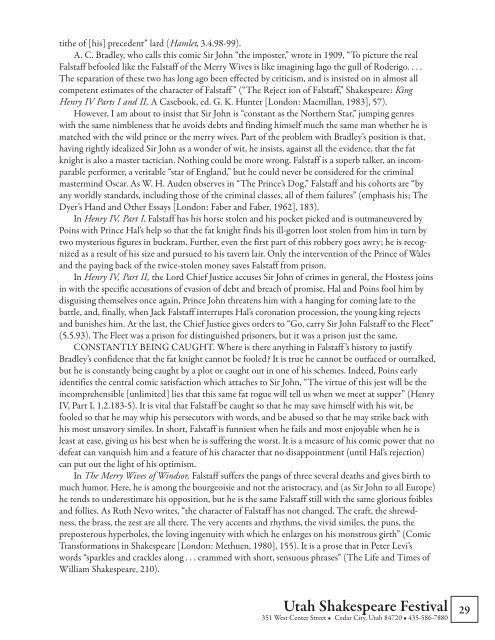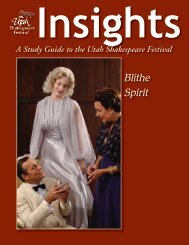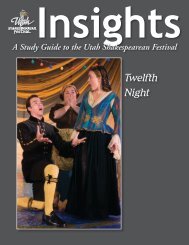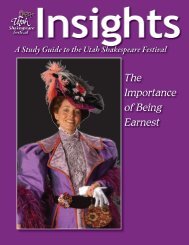View and print the complete guide in a pdf file. - Utah ...
View and print the complete guide in a pdf file. - Utah ...
View and print the complete guide in a pdf file. - Utah ...
You also want an ePaper? Increase the reach of your titles
YUMPU automatically turns print PDFs into web optimized ePapers that Google loves.
ti<strong>the</strong> of [his] precedent” lard (Hamlet, 3.4.98-99).A. C. Bradley, who calls this comic Sir John “<strong>the</strong> imposter,” wrote <strong>in</strong> 1909, “To picture <strong>the</strong> realFalstaff befooled like <strong>the</strong> Falstaff of <strong>the</strong> Merry Wives is like imag<strong>in</strong><strong>in</strong>g Iago <strong>the</strong> gull of Roderigo. . . .The separation of <strong>the</strong>se two has long ago been effected by criticism, <strong>and</strong> is <strong>in</strong>sisted on <strong>in</strong> almost allcompetent estimates of <strong>the</strong> character of Falstaff ” (“The Reject ion of Falstaff,” Shakespeare: K<strong>in</strong>gHenry IV Parts I <strong>and</strong> II, A Casebook, ed. G. K. Hunter [London: Macmillan, 1983], 57).However, I am about to <strong>in</strong>sist that Sir John is “constant as <strong>the</strong> Nor<strong>the</strong>rn Star,” jump<strong>in</strong>g genreswith <strong>the</strong> same nimbleness that he avoids debts <strong>and</strong> f<strong>in</strong>d<strong>in</strong>g himself much <strong>the</strong> same man whe<strong>the</strong>r he ismatched with <strong>the</strong> wild pr<strong>in</strong>ce or <strong>the</strong> merry wives. Part of <strong>the</strong> problem with Bradley’s position is that,hav<strong>in</strong>g rightly idealized Sir John as a wonder of wit, he <strong>in</strong>sists, aga<strong>in</strong>st all <strong>the</strong> evidence, that <strong>the</strong> fatknight is also a master tactician. Noth<strong>in</strong>g could be more wrong. Falstaff is a superb talker, an <strong>in</strong>comparableperformer, a veritable “star of Engl<strong>and</strong>,” but he could never be considered for <strong>the</strong> crim<strong>in</strong>almasterm<strong>in</strong>d Oscar. As W. H. Auden observes <strong>in</strong> “The Pr<strong>in</strong>ce’s Dog,” Falstaff <strong>and</strong> his cohorts are “byany worldly st<strong>and</strong>ards, <strong>in</strong>clud<strong>in</strong>g those of <strong>the</strong> crim<strong>in</strong>al classes, all of <strong>the</strong>m failures” (emphasis his; TheDyer’s H<strong>and</strong> <strong>and</strong> O<strong>the</strong>r Essays [London: Faber <strong>and</strong> Faber, 1962], 183).In Henry IV, Part I, Falstaff has his horse stolen <strong>and</strong> his pocket picked <strong>and</strong> is outmaneuvered byPo<strong>in</strong>s with Pr<strong>in</strong>ce Hal’s help so that <strong>the</strong> fat knight f<strong>in</strong>ds his ill-gotten loot stolen from him <strong>in</strong> turn bytwo mysterious figures <strong>in</strong> buckram. Fur<strong>the</strong>r, even <strong>the</strong> first part of this robbery goes awry; he is recognizedas a result of his size <strong>and</strong> pursued to his tavern lair. Only <strong>the</strong> <strong>in</strong>tervention of <strong>the</strong> Pr<strong>in</strong>ce of Wales<strong>and</strong> <strong>the</strong> pay<strong>in</strong>g back of <strong>the</strong> twice-stolen money saves Falstaff from prison.In Henry IV, Part II, <strong>the</strong> Lord Chief Justice accuses Sir John of crimes <strong>in</strong> general, <strong>the</strong> Hostess jo<strong>in</strong>s<strong>in</strong> with <strong>the</strong> specific accusations of evasion of debt <strong>and</strong> breach of promise, Hal <strong>and</strong> Po<strong>in</strong>s fool him bydisguis<strong>in</strong>g <strong>the</strong>mselves once aga<strong>in</strong>, Pr<strong>in</strong>ce John threatens him with a hang<strong>in</strong>g for com<strong>in</strong>g late to <strong>the</strong>battle, <strong>and</strong>, f<strong>in</strong>ally, when Jack Falstaff <strong>in</strong>terrupts Hal’s coronation procession, <strong>the</strong> young k<strong>in</strong>g rejects<strong>and</strong> banishes him. At <strong>the</strong> last, <strong>the</strong> Chief Justice gives orders to “Go, carry Sir John Falstaff to <strong>the</strong> Fleet”(5.5.93). The Fleet was a prison for dist<strong>in</strong>guished prisoners, but it was a prison just <strong>the</strong> same.CONSTANTLY BEING CAUGHT. Where is <strong>the</strong>re anyth<strong>in</strong>g <strong>in</strong> Falstaff ’s history to justifyBradley’s confidence that <strong>the</strong> fat knight cannot be fooled? It is true he cannot be outfaced or outtalked,but he is constantly be<strong>in</strong>g caught by a plot or caught out <strong>in</strong> one of his schemes. Indeed, Po<strong>in</strong>s earlyidentifies <strong>the</strong> central comic satisfaction which attaches to Sir John, “The virtue of this jest will be <strong>the</strong><strong>in</strong>comprehensible [unlimited] lies that this same fat rogue will tell us when we meet at supper” (HenryIV, Part I, 1.2.183-5). It is vital that Falstaff be caught so that he may save himself with his wit, befooled so that he may whip his persecutors with words, <strong>and</strong> be abused so that he may strike back withhis most unsavory similes. In short, Falstaff is funniest when he fails <strong>and</strong> most enjoyable when he isleast at ease, giv<strong>in</strong>g us his best when he is suffer<strong>in</strong>g <strong>the</strong> worst. It is a measure of his comic power that nodefeat can vanquish him <strong>and</strong> a feature of his character that no disappo<strong>in</strong>tment (until Hal’s rejection)can put out <strong>the</strong> light of his optimism.In The Merry Wives of W<strong>in</strong>dsor, Falstaff suffers <strong>the</strong> pangs of three several deaths <strong>and</strong> gives birth tomuch humor. Here, he is among <strong>the</strong> bourgeoisie <strong>and</strong> not <strong>the</strong> aristocracy, <strong>and</strong> (as Sir John to all Europe)he tends to underestimate his opposition, but he is <strong>the</strong> same Falstaff still with <strong>the</strong> same glorious foibles<strong>and</strong> follies. As Ruth Nevo writes, “<strong>the</strong> character of Falstaff has not changed. The craft, <strong>the</strong> shrewdness,<strong>the</strong> brass, <strong>the</strong> zest are all <strong>the</strong>re. The very accents <strong>and</strong> rhythms, <strong>the</strong> vivid similes, <strong>the</strong> puns, <strong>the</strong>preposterous hyperboles, <strong>the</strong> lov<strong>in</strong>g <strong>in</strong>genuity with which he enlarges on his monstrous girth” (ComicTransformations <strong>in</strong> Shakespeare [London: Methuen, 1980], 155). It is a prose that <strong>in</strong> Peter Levi’swords “sparkles <strong>and</strong> crackles along . . . crammed with short, sensuous phrases” (The Life <strong>and</strong> Times ofWilliam Shakespeare, 210).<strong>Utah</strong> Shakespeare Festival351 West Center Street • Cedar City, <strong>Utah</strong> 84720 • 435-586-788029
















